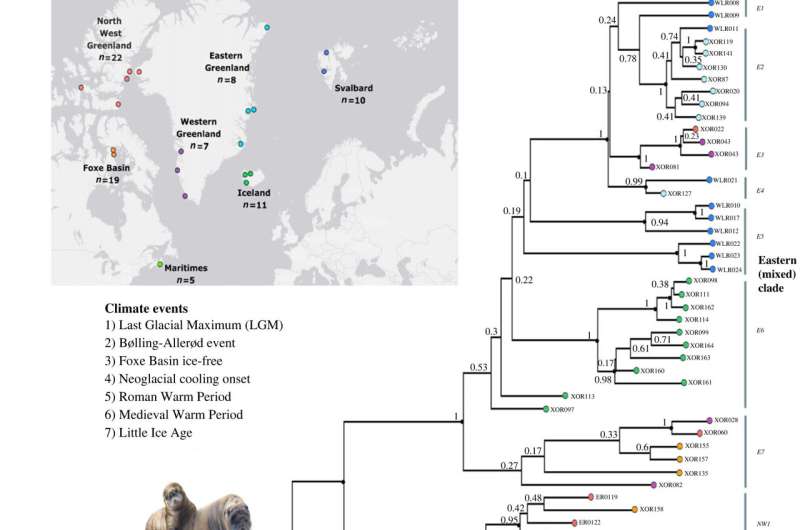This article has been reviewed according to Science X's editorial process and policies. Editors have highlighted the following attributes while ensuring the content's credibility:
fact-checked
peer-reviewed publication
trusted source
proofread
Atlantic walrus more vulnerable than ever to Artic warming

Past cycles of climate change, along with human exploitation, have led to only small and isolated stocks of Atlantic walrus remaining. The current population is at high risk of the same issues affecting them severely, according to a new study led by Lund University in Sweden published in the Proceedings of the Royal Society B: Biological Sciences.
Today, the last remaining stocks of Atlantic walrus are threatened more than ever, due to a combination of Arctic warming and a long history of devastating human exploitation. Rising global temperatures are significantly impacting Arctic marine ecosystems and their inhabitants. However, little is known about exactly how this combination of stress factors will impact Arctic species.
Now, researchers have examined how walruses have coped with past cycles of climate change. Using breakthroughs in ancient genomics, the team was able to extract, sequence and interpret ancient genetic information contained in teeth and bone that survive well in the Arctic's frozen archaeological sites. These DNA results were integrated with modern genetic samples, enabling the team to reconstruct how the genetic diversity of the Atlantic walrus had changed under earlier cycles of global warming.
"We found that Arctic warming has led to a surprisingly high genetic separation of local walrus stocks. Because they have very specific habitat requirements such as how they feed, for example, this has led to the rapid spreading, isolation and in many cases extinction of walrus stocks," says Peter Jordan, Professor of Archaeology at Lund University.
The last Ice Age peaked between about 27,000 and 19,000 years ago. At this time the Arctic was buried under kilometers of glacial ice sheets, and so marine mammals were pushed southwards to areas of ice floes and more open water. Walrus survived in some areas of the Atlantic located further to the south, and as soon as climates warmed again, the ice edge retreated and walrus populations pushed quickly northwards again. This combination of warming and climate-driven dispersal led to local walrus populations becoming more genetically differentiated.
In addition, during the last thousand years, human hunting and commercial exploitation has led to numerous local extinction events. These include the expansion of Norse settlers into Iceland and the North Atlantic in pursuit of walrus ivory, which was a valuable trade good, and in more recent times, with industrial scale culling of walrus populations.
Currently, the genetic diversity of walrus stocks is a fragment of what existed earlier, making them even more vulnerable to pressures such as accelerating ice loss, disturbance by Arctic shipping, resource extraction and mass tourism, according to the researchers.
"As Arctic sea ice retreats, the depleted walrus stocks will disperse further into smaller and more isolated pockets, where the genetic isolation and reduced connectivity makes them ever more vulnerable to other stressors such as Arctic shipping, resource extraction and large-scale tourism," says Jordan.
"Our results underscore the urgency of rethinking conservation goals for species in rapidly changing Arctic marine environments," he concludes.
More information: Emily J. Ruiz-Puerta et al, Holocene deglaciation drove rapid genetic diversification of Atlantic walrus, Proceedings of the Royal Society B: Biological Sciences (2023). DOI: 10.1098/rspb.2023.1349
Journal information: Proceedings of the Royal Society B
Provided by Lund University

















